Campxis is another wonderful liana, having a pivest leaves and can decorate a veranda, a fence or a wall of the house with its bright tubular flowers throughout the summer. Will there be a successful campsis in the middle lane? What conditions does he need to create so that he surprised his exotic flowers?
What does Campxice look like?
This is a large perennial decorated liana over time, included in the Bignon family. Easies can be fixed on a vertical support with the help of air roots and reach lengths of 5-10 meters. The sheets are complex, unpactarous, consist of seven, nine or eleven small leaves, the edges of which are sawn. Campxice flowers are quite large (medium diameter of 5 centimeters, and length 9 centimeters), tubular, have similarities with miniature gramophilics, the smell does not exude. They form small inflorescences at the ends of the escapes - sweatshirts. In some varieties of color orange-red, others can have salmon, raspberry, yellow, pink, reddish-golden. The first flowers are revealed already in June, and the flowering period is completed on the first autumn month. Although there are no smell of flowers, but these large tubes attract the attention of the OS, the bees-workers, ants, flies. Bignony fruits are harsh, leathery elongated shape pods. Their size is from 8 to 10 centimeters. Inside ripens a lot of connectable winged seeds. When the pod cracks into two halves, they will fly away. The roots of this plant are sprawling in different directions.
The people in different ways are called Campxis: Techoms, Teomaria, Bignonia, Trubnocet.
Let's tell me that Teomaria, Techoms and Campxis is not exactly the same thing, these are still representatives of various kinds, although they belong to one family.
"Camptein" can be translated from Greek as "bending", "twist." And the name is associated with a winding bizarre trunk of these Lian or with twisting sticks.
Two types allocate nerds in this way:
- Campxis rooting (his homeland is North America). This bignonium is able to climb on fifteen meters altitude thanks to air roes. From above, unpacturous leaves of this liana naked, bright green, and from the bottom - pubescent. Leaf size - 20 centimeters. The top brushes are presented ten or fifteen large tubular-funnel-shaped flowers. Their size in length reaches nine centimeters, and the diameter can be up to five centimeters. The whisk is saturated with orange color, and the binding of the flame red. After flowering on the plant, long podlovoid boxes appear.
There are several beautiful forms of this type:
- Gorgeous (grows as a bush, has thin shoots and flowers of red-orange color);
- Early (on it formerly everyone is formed large flowers painted in bright red color);
- Golden (painting its yellow flowers);
- Dark purple (has bright red flowers with a purple tint).
Let's call a few attractive varieties of this type of Bignony:
- "Flamenco" - from July and before the arrival of frosts of Liana is decorated with purple-red flowers;
- "Judy" - a reddish-golden flowers are formed on this Liane;
- "Flava" - on the bush from July and until September, saturated yellow flowers are revealed.
- Campxis Largender, Chinese (Natural Habitat - China, Japan). This type of shoots do not have air roots, so they are attached to the parts of the support with their tips, or the liana and is growing at all as a bush. Leaves are also complex, but smaller sizes (up to six centimeters), without omission. But this kind of flowers gives more spectacular, large (the diameter of one is eight centimeters). Painted in reddish-orange color, in the form of tubular-funnels. Seeds ripen in long pods. Frost resistance is much lower than that of rooting. There is a form on which orange flowers (Campxis Tunberg) are revealed.
Thanks to the two types described, breeders were able to create a hybrid campsis. It usually grows as a magnificent bush with a spreaded crown. Curly lianas are less likely. His flowers are comparable to those giving Campxis large-flowered. But another positive quality is frost resistance, he inherited from his second "parent" - Campxis rooting. The famous variety Madame Galen - apricot color flowers are formed on a shrub Liana.
Features of the landing of Campxis
The landing of this plant in the open ground in the Moscow region or other areas of the middle band is produced after May 15. Place for Liana is better to choose on the southern or southeastern side of the land plot protected from drafts and busting winds. Do not place Campxis next to the windows of the house, because many insects fly to its flowers. Liana does not put forward special requirements, it feels normally even on limestone soil. The main thing is that in the soil there was a sufficient number of microelements and minerals. Usually for a cutlery, it is enough to dig the pit of the following dimensions: 40x50x50 centimeters. That soil, which was taken out of the pit, mix with the mineral complex (in the amount of 500 grams) and the compost (it is necessary 5 kilograms). Part of this mixture immediately put in the pit, then on the hilly, spread the roots of your pet, and then fully fill the remaining nourishing soil space. As a result, the seedling in a new place should be at the same depth, to which it was used earlier. Lightly accumulate the earth near the seedling, and then watering. Wait for the earth slightly dried, and inspire peat or earth from the compost pit. Do not forget that the shoots of Campxis must necessarily need a support, otherwise they will grow as soil workers.
Further recommendations for Campsis Care
The main elements from which the care of this Lian is developing:
- watering;
- periodic loosening, combined with the removal of weeds appearing in the ground;
- feeding;
- mandatory trimming;
- prevention of pests and diseases;
- preparation for wintering.
In climbing Campxis, the golden middle is important, this plant can not be poured nor overwhelming the soil around it. Swimming and quiet Try to do when the soil is wet, then you spend less strength and time.
The secret of abundant flowering is an introduction to the soil of nitrogen-phosphoric fertilizers.
Form a beautiful neat liano helps periodic trimming. As soon as the seedling or small bush was planted, all his shoots doinched, leaving 15 centimeters from the ground. In the future, it is recommended to leave the plant only 5 of the strongest shoots. These growing shoots send along the vertical support. If there is a need, you can also be tiered. For three years, the plant reaches four-meter height. Side shoots every year shock up to three eyes. Weak, affected by diseases, non-composite shoots completely cut. If for some reason a skeletal branch will be damaged, then remove it, and then try to send a replacement escape into its place.
An aging liano can be rejected by the following way. Cut all bush branches at 30 centimeters from the ground.
It is desirable to carry out the pruning procedure before waking up the kidneys on shoots, that is, at the beginning of spring.
If desired in summer, with the help of a secaterator and special designs, you can create bizarre figures or green hedges.
Campxises who are grown from seeds, the first flowers show only on the 4-6th year of their lives. If you managed to buy a cutlets of Campxis and put, he will bloom on the third year of life. Campxis may not give flowers for the following reasons:
- Growing in the regions with a cold climate.
- Fit plants under late frosts.
- Habitat in a place where drafts are walking.
- Serious liana diseases or pest damage.
- Poor soils.
- Lack of trimming, because old branches periodically need to be removed, the flowers are typked on new shoots.
It should be noted that if Campxis lives in conditions favorable for him, he rarely suffers from diseases, pests do not touch it. If these plants are overly watered, then they begin to rot the roots, which negatively affects them and appearance. If the summer is represented by hot, arid, then the campsies can set up colonies of Tly, sucking their juices. In this case, it is possible to prepare such a solution for spraying, in ten liters of water to stir 10 grams of sputty soap on a cooker. Or you can use the "chemistry", for example, "Aktar".
Campxis breeding options
Gardeners resort to two ways:
- with the help of seeds (geneant breeding path);
- with the help of root row, cuttings (green or weird over time), as well as grains (all this vegetative reproduction paths).
Seeds of special storage conditions do not require, they can safely lie all winter in indoor conditions, they do not need to strategy or somehow process. In the spring (in March), they simply need to sow in the drawers with a wet, pre-pendant substrate, the reaction of the medium is neutral. The depth of the seal is about 5 millimeters. The boxes should be left in the room where the temperature is within 25 degrees, then in a month (or a little earlier), the long-awaited shoots will be projected. For permanent place in the garden, such seedlings can be replant when they will grow three pairs of real leaves.
If there is an opportunity to take green young cuttings from adult campsis, then they must be triggered in June or July. Each cutlets leave three upper sheets, just shorten them for two thirds. Make a loose garden for them. In fertile soil, placing cuttings under some inclination (about 45 degrees). In the future, these landings need moistening of soil and mulching. Experience shows that on average 90% of such cuttings are rooted.
Wearing stalks cut off with a weathered sprouts in the spring. They are also placed in the ground under the tilt. Their accessibility is much higher.
If the Lianana appeared next to the so-called root piglery, then you can dig up well-developed roasting processes and moves to another site location. Time for such a procedure is the beginning of spring or days after leaf fall.
And now I will introduce with the method of reproduction by the gifts. If the spring shoots noticed that they grow close to the ground, then hurt them to the soil. Lock with wire brackets. Soil constantly moisturize throughout the summer. After a year, at the beginning of Spring, it is possible to rejuvenate from Liana.
How is Campxis?
Reviews of growing Campxis in the middle lane indicate that plants normally transfer periods when the temperature drops to the "minus 20 degrees". If the winter is colder in your winter regions, then for the winter campsi will have to be covered. In this case, Lianams need to build removable (rope or wire) supports so that in the winter it is possible to quickly and easily remove along with shoots. After wintering, they must also be easily restored. Curly shoots to the cold are removed from the supports, lay out on the ground, then the dry foliage ohapps are poured on top either cover the shoots with spruce "paws". Next, "Stack" is covered with a film. The next layer of insulation is again firing "paws".
If your liana is growing around the arch, it is possible to keep the roots, pouring sand or fir branches. All shoots should be wrapped with Loutrasil (a few layers), on top of the wet snow, make protection by throwing the film to the observer material. In the spring, the shoots of Campxis, wounded on the ground, quickly distribute the supports and encourage. Inspect them if some poorly moved the cold, you will have to cut them carefully.
Quickly and energetically growing elegant liana is capable of disguise in a short time to disguise the fence, grille, shed, arch. Just observe the distance if you decided to plant Campxis at the wall of the house, otherwise its roots will damage the foundation. And do not place Liana from brightly colored arbors. The fact is that the air root of the pipe-flow is isolated adhesive mass, it can harm the paint layer.

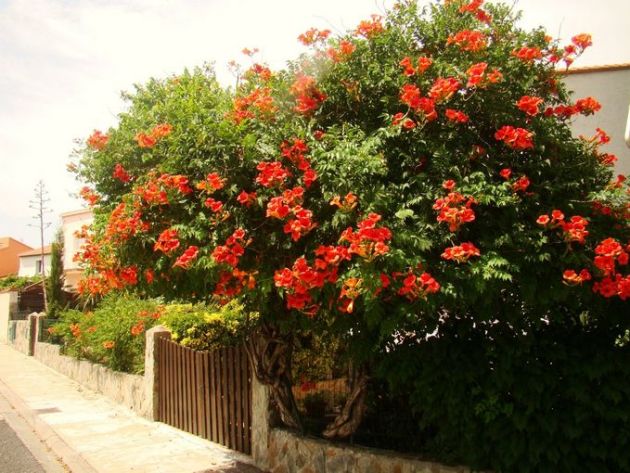
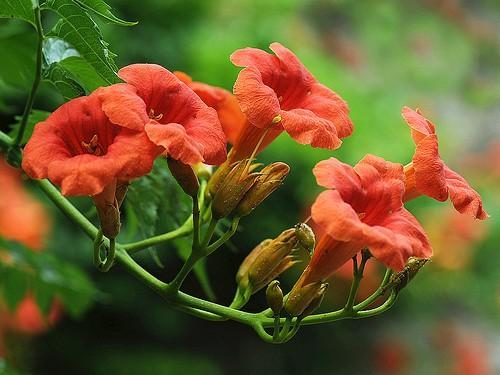
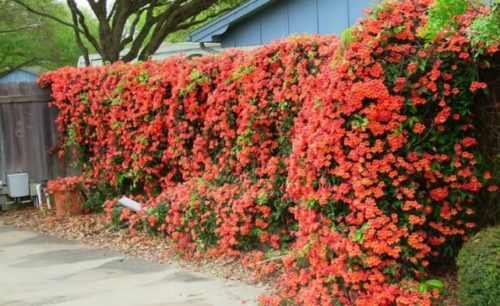
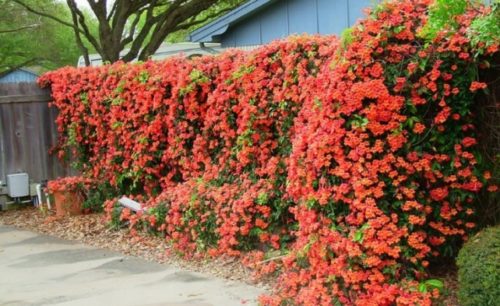
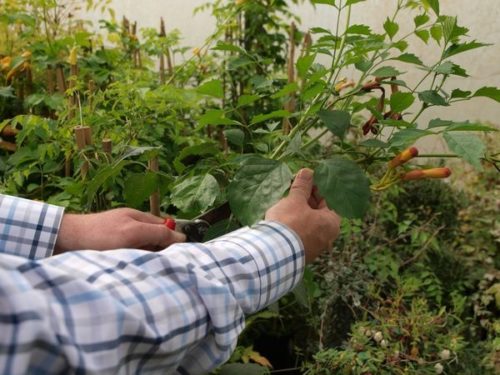
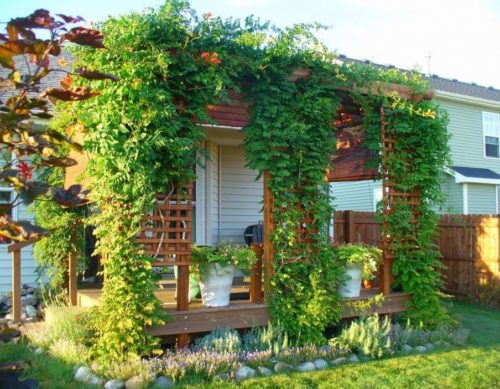
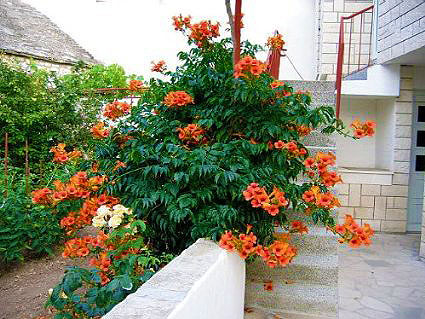
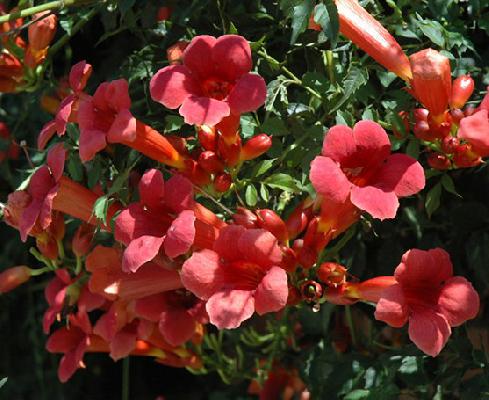
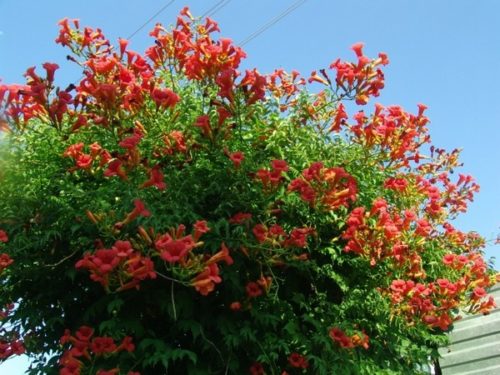
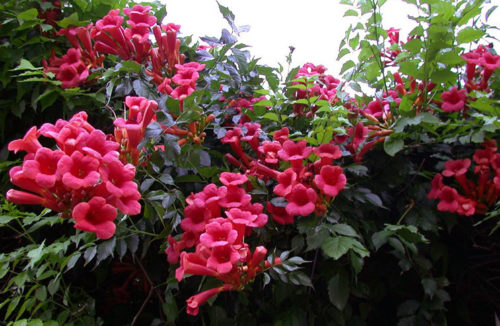

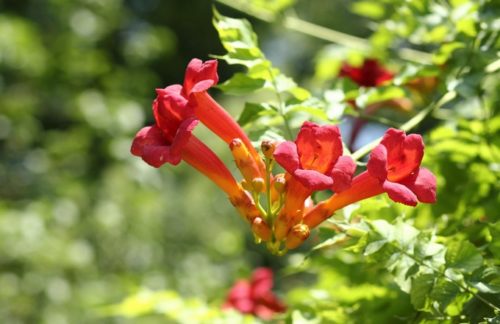












 Start a discussion ...
Start a discussion ...